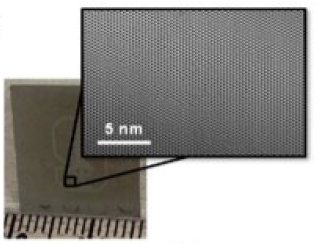Researchers Demonstrate Super-Thin Semiconductor Deposition for Temperature Sensing
Outcome/Accomplishment
The first-ever demonstration of a large-temperature coefficient through a super-thin semiconducting layer was conducted by researchers at the Center for Power Optimization of Electro-Thermal Systems (POETS), an NSF-funded Engineering Research Center (ERC) based at the University of Illinois.
Impact/Benefits
No commercial product exists that can sense temperature changes with such atomically thin semiconducting materials. The work at POETS could enable condition-based monitoring and diagnostics of critical electronic components and help meet the need for novel electrical and thermal component designs for POETS testbed systems.
Explanation/Background
Temperature sensing is critical for numerous applications in electronics, including the suppression of thermal failures in integrated circuits. Traditional temperature sensors rely on thermocouples, resistors, or circuit-based sensors that cannot be placed with microscale precision and cannot respond to ultrafast temperature changes.
The POETS researchers demonstrated a novel transfer technique for two-dimensional semiconductor materials, resulting in a monolayer thickness of 0.6 nm. The technique incorporated contacts on polyimide substrates that will provide the basis for integration into power modules.
Location
Urbana-Champaign, Illinoiswebsite
Start Year
Microelectronics and IT
Microelectronics, Sensing, and IT
Lead Institution
Core Partners
Fact Sheet
Outcome/Accomplishment
The first-ever demonstration of a large-temperature coefficient through a super-thin semiconducting layer was conducted by researchers at the Center for Power Optimization of Electro-Thermal Systems (POETS), an NSF-funded Engineering Research Center (ERC) based at the University of Illinois.
Location
Urbana-Champaign, Illinoiswebsite
Start Year
Microelectronics and IT
Microelectronics, Sensing, and IT
Lead Institution
Core Partners
Fact Sheet
Impact/benefits
No commercial product exists that can sense temperature changes with such atomically thin semiconducting materials. The work at POETS could enable condition-based monitoring and diagnostics of critical electronic components and help meet the need for novel electrical and thermal component designs for POETS testbed systems.
Explanation/Background
Temperature sensing is critical for numerous applications in electronics, including the suppression of thermal failures in integrated circuits. Traditional temperature sensors rely on thermocouples, resistors, or circuit-based sensors that cannot be placed with microscale precision and cannot respond to ultrafast temperature changes.
The POETS researchers demonstrated a novel transfer technique for two-dimensional semiconductor materials, resulting in a monolayer thickness of 0.6 nm. The technique incorporated contacts on polyimide substrates that will provide the basis for integration into power modules.

